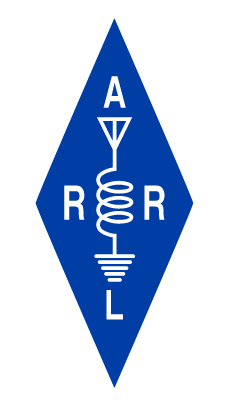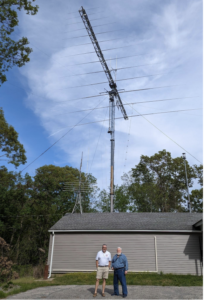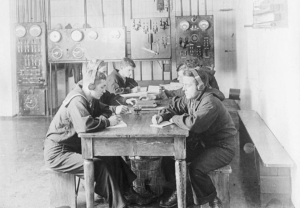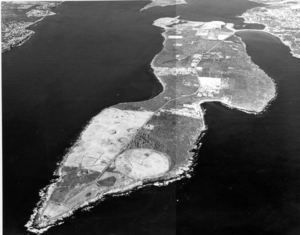Rhode Island is a small state with a rich history. The Providence Radio Association invests in RI’s radio legacy by maintaining a historic Collins 237B-1 rotatable 13 element log periodic antenna originally installed as part of NAVCOMMSTA Newport’s impressive transmit antenna farm on Beavertail Point, Jamestown RI from c.1964-1975. On Saturday 13 May 2023, the Providence Radio Association again participated in the MARS Armed Forces Day (AFD) Crossband Test using their historic antenna and the equally historic call sign, NAF.
NAF began operation from the Naval Torpedo Station, Newport, RI c. 1900, and was among the first US Naval Radio shore stations. Eventually, several naval radio stations were consolidated as NAVCOMMSTA Newport. NAF transmitted from c.1900 until 1975 at various coastal Narragansett Bay locations, including NAVRADSTA (T) Beavertail Point (Jamestown).
The Providence Radio Association shares the next chapter in this rich Rhode Island radio history: “The drastic curtailment of naval operations on Narragansett Bay in 1975 closed all naval activities at Sachuest Point and Beavertail Point. In 1975 the Navy allowed the Providence Radio Association to hold its annual Field Day exercises at the Beavertail Station. Following the decommissioning of the facility and turn over to land of the State, in 1983 the PRA acquired one of the Collins 237B-1 rotatable log periodic antennas used by NAF and erected it at our club facility in Johnston, RI. It has been utilized since then under the Amateur call sign W1OP. Once a year, we either operate from the original NAVRADSTA (T) location at Beavertail Pt, or we use this antenna from our clubhouse in Johnston to participate in the Armed Forces Day Crossband Test, using its original naval call sign NAF.”
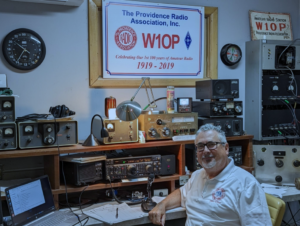
For this year’s AFD Crossband Test, the Providence Radio Association again got permission to operate as NAF and transmit on their restored original Collins antenna. The W1OP clubhouse on Neutaconkanut Hill (on the Providence/Johnston border) opened its impressive radio station to members and Amateur Radio guests, including: Dom, N1DM; David, W3DRE; Doug, K3DRE; Andy, AJ1S; John, W1GS; Dave, K1DT; Teri, W1PUP; Jeremy, K1JST; Adam, KC1KCC; and Nancy, KC1NEK. Hundreds of phone QSOs were logged on mostly 20m and 40m.
As the ARRL notes: “The AFD Crossband Test is a unique opportunity to test two-way communications between military communicators and radio stations in the Amateur Radio Service (ARS), as authorized in 47 CFR 97.111. These tests provide opportunities and challenges for radio operators to demonstrate individual technical skills in a tightly controlled exercise scenario. Military stations will transmit on selected frequencies and will announce the specific ARS frequencies monitored. All of the times are Zulu (Z), and all frequencies are Upper Side Band (USB) unless otherwise noted.”
For more on the history of call sign NAF and their restored Collins antenna, reach out to Providence Radio Association club president Dave Tessitore “Tess”, K1DT, at k1dt@verizon.net.
Radio communication has a long history in Rhode Island. By 1900, Newport’s naval officers were given instruction in wireless technology. Newport’s Torpedo Station was one of the first of a network of U.S. Navy shore radio stations, along with an adjacent site at the Naval Training Center used to train radio operators for the Navy. From c.1964 until 1975, Sachuest Point on Aquidneck Island and Beavertail on Jamestown served as key receive and transmit stations. Today, Amateur Radio offers an experiential learning gateway to 21st century workforce development opportunities in electronics and wireless radio communication, both analog and digital. This highly relevant mission is at the heart of many ARRL-affiliated RI radio clubs.
—
For more information, see also:
https://www.arrl.org/news/
https://www.navy-radio.com/
https://www.navy-radio.com/
